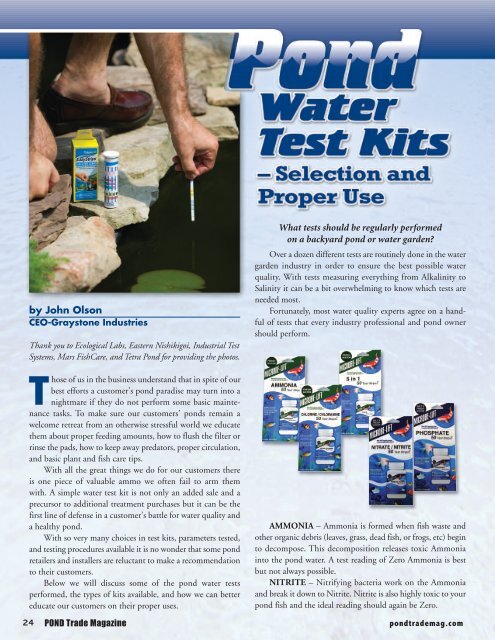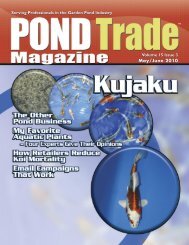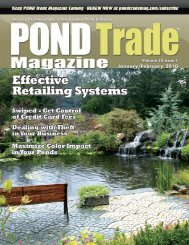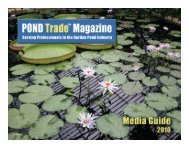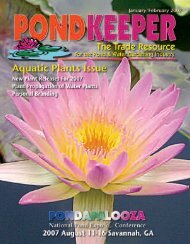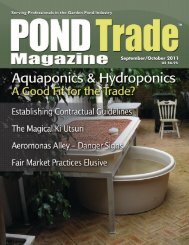Download the January / February, 2011 PDF - Pond Trade Magazine
Download the January / February, 2011 PDF - Pond Trade Magazine
Download the January / February, 2011 PDF - Pond Trade Magazine
- No tags were found...
You also want an ePaper? Increase the reach of your titles
YUMPU automatically turns print PDFs into web optimized ePapers that Google loves.
y John OlsonCEO-Graystone IndustriesThank you to Ecological Labs, Eastern Nishikigoi, Industrial TestSystems, Mars FishCare, and Tetra <strong>Pond</strong> for providing <strong>the</strong> photos.Those of us in <strong>the</strong> business understand that in spite of ourbest efforts a customer’s pond paradise may turn into anightmare if <strong>the</strong>y do not perform some basic maintenancetasks. To make sure our customers’ ponds remain awelcome retreat from an o<strong>the</strong>rwise stressful world we educate<strong>the</strong>m about proper feeding amounts, how to flush <strong>the</strong> filter orrinse <strong>the</strong> pads, how to keep away predators, proper circulation,and basic plant and fish care tips.With all <strong>the</strong> great things we do for our customers <strong>the</strong>reis one piece of valuable ammo we often fail to arm <strong>the</strong>mwith. A simple water test kit is not only an added sale and aprecursor to additional treatment purchases but it can be <strong>the</strong>first line of defense in a customer’s battle for water quality anda healthy pond.With so very many choices in test kits, parameters tested,and testing procedures available it is no wonder that some pondretailers and installers are reluctant to make a recommendationto <strong>the</strong>ir customers.Below we will discuss some of <strong>the</strong> pond water testsperformed, <strong>the</strong> types of kits available, and how we can bettereducate our customers on <strong>the</strong>ir proper uses.What tests should be regularly performedon a backyard pond or water garden?Over a dozen different tests are routinely done in <strong>the</strong> watergarden industry in order to ensure <strong>the</strong> best possible waterquality. With tests measuring everything from Alkalinity toSalinity it can be a bit overwhelming to know which tests areneeded most.Fortunately, most water quality experts agree on a handfulof tests that every industry professional and pond ownershould perform.AMMONIA – Ammonia is formed when fish waste ando<strong>the</strong>r organic debris (leaves, grass, dead fish, or frogs, etc) beginto decompose. This decomposition releases toxic Ammoniainto <strong>the</strong> pond water. A test reading of Zero Ammonia is bestbut not always possible.NITRITE – Nitrifying bacteria work on <strong>the</strong> Ammoniaand break it down to Nitrite. Nitrite is also highly toxic to yourpond fish and <strong>the</strong> ideal reading should again be Zero.24 POND <strong>Trade</strong> <strong>Magazine</strong>pondtrademag.com


